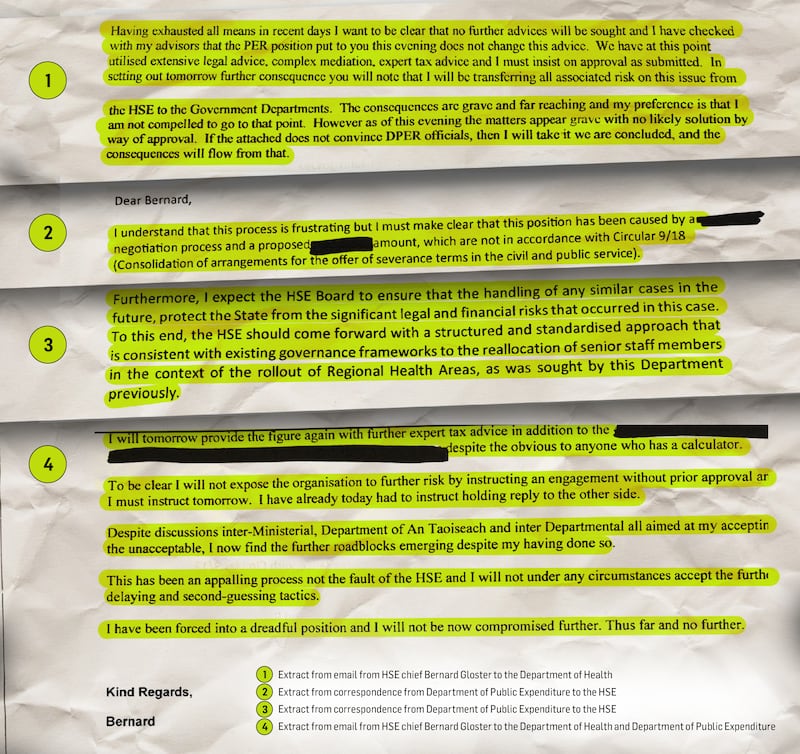At the end of February the Government circulated a briefing note to Ministers who were scheduled to appear in public or do media interviews the following day.
The Government had been tipped off by the HSE that The Irish Times was scheduled to reveal that one of the most senior executives in the health service was to receive a package of close to €400,000 on his departure under a deal formally approved a few days earlier.
In the wake of the controversy over payments at RTÉ, the Government was aware the story could cause a storm.
The note said the package given to Dean Sullivan, who had been appointed to the HSE six and a half years earlier, initially as deputy director general, was made up of two components: a legal settlement and a severance payment under the terms of rules in place for the public service.
READ MORE
Both elements of the deal had received “all of the appropriate approvals in advance of the payments being made”, the note said.
That was true. But newly-released official files show there had been a furious row behind the scenes before it was ultimately sanctioned.
[ HSE attempts to pay substantial exit package to former top executive led to Government row ]
Taoiseach Simon Harris repeated the lines in the briefing note when he appeared on Morning Ireland, on RTÉ Radio 1, on February 29th.
Some Ministers, however, did not need the briefing material and were fully aware of the Sullivan deal and the row it had generated.
Minister for Health Stephen Donnelly and Minister for Public Expenditure Paschal Donohoe had held talks on the issue. The top adviser to the then-taoiseach Leo Varadkar was also copied into some of the correspondence.

The files say that Donohoe told Donnelly on January 19th that while he was eager to resolve the case, he was “at the limits of what he can agree to”.
The HSE said that Sullivan had departed “by agreement and redundancy”. However, it has never provided any real explanation on the case, including how it came about or why there was a legal settlement. The HSE says it is bound by a confidentiality agreement.
The files suggest there was a mediation process involving the HSE and Sullivan finalised around October last year. A proposed agreement was provided to the Department of Public Expenditure in early November, where it immediately set off alarm bells. Ultimately, it refused to sanction the initial HSE proposal.
[ Senior HSE executive secures €389,000 in exit deal approved in recent daysOpens in new window ]
Subsequently, in a series of increasingly angry emails, HSE chief executive Bernard Gloster warned of “risks” and “grave consequences” if the deal negotiated with Sullivan was not approved.
On January 18th he told the departments of Health and Public Expenditure: “Despite discussions inter-Ministerial, Department of An Taoiseach and inter-departmental all aimed at my accepting the unacceptable, I now find the further roadblocks emerging despite my having done so.
“This has been an appalling process not the fault of the HSE and I will not under any circumstances accept further delaying and second guessing tactics.
“I have been forced into a dreadful position and I will not be now compromised further. Thus far and no further.”
The HSE has refused to elaborate on the “risks” it referred to in the correspondence.
Government agencies can agree exit packages with senior staff. However, the Department of Public Expenditure believed that the HSE had not followed correct procedures.
It said the HSE initial agreement appeared to have been reached without its prior consent.
Perhaps more importantly for it, the Department of Public Expenditure said the original HSE agreement contained an ex gratia payment that exceeded the limit of three weeks’ salary per year of service set out under the official circular governing such exit packages.
The overall payment initially proposed may have been close to the €388,983 ultimately paid out. However, the Department of Public Expenditure was determined to avoid a larger severance payment than provided for in the circular as this could set a precedent.
[ Explainer: Exit deals and payoffs in publicly funded organisationsOpens in new window ]
On January 19th it told Gloster it could not approve a severance amount at the level originally proposed “given the precedent and risks it would pose for future public sector severance cases through its undermining of the limits in the circular”.
It said it was only willing to consider agreement to the proposed overall level of payment in this case “due to the levels of legal and financial risk (as set out in the legal settlement form and legal advices) that the handling of all aspects of this case has opened the State up to”.
The HSE ultimately agreed a revised formula that was formally approved by the Department of Public Expenditure on February 14th.
Among the conditions were that in any “reallocation” of senior staff as part of new HSE structural reforms, it would have to come up with a “standardised approach in keeping with existing governance frameworks”. In addition, the HSE had to meet the cost of the payment from its existing resources. There would be no further money provided.
- Sign up for push alerts and have the best news, analysis and comment delivered directly to your phone
- Find The Irish Times on WhatsApp and stay up to date
- Listen to our Inside Politics podcast for the best political chat and analysis













